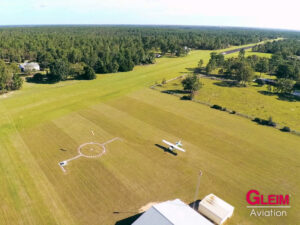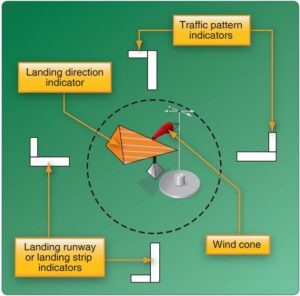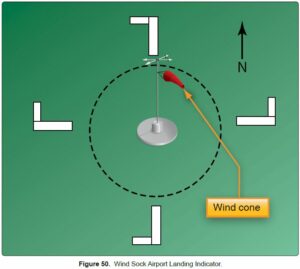
One of the most common questions we get from students in the Gleim Online Ground School is how to interpret a segmented circle. Many people are confused by the segmented circle figures provided in the FAA Testing Supplement, or believe them to have errors, because they do not seem to have enough information to answer questions about selecting a runway and direction of turns in the traffic pattern. However, most of these concerns are alleviated after a quick explanation of the different components of segmented circles.
A segmented circle is a visual indicator that provides traffic pattern information to pilots at airports without a control tower. You will be able to see the segmented circle on the ground as you fly over the airport and determine the correct runway to land on and  the correct traffic pattern.
the correct traffic pattern.
Each segmented circle consists of three components: the landing runway indicators, the traffic pattern indicators, and the wind cone. Each gives pilots a different piece of information to determine the correct traffic pattern to fly and the correct runway to land on.
There are no runway numbers depicted, but the orientation of the segmented circle will closely match the orientation of the actual runways. For example, if a north/south runway is depicted by the segmented circle, it could represent runway 18/36, 17/35, or 01/19, depending on which runways the airport actually has. During your knowledge test, you can determine the correct runway numbers from the information given in the answer choices.
Let’s take a look at a sample question from the Private Pilot Knowledge Test to help us understand how to interpret segmented circles.
 (Refer to Figure 50.) Which runway and traffic pattern should be used as indicated by the wind cone in the segmented circle?
(Refer to Figure 50.) Which runway and traffic pattern should be used as indicated by the wind cone in the segmented circle?
A. Left-hand traffic on Runway 9.
B. Right-hand traffic on Runway 27.
C. Right-hand traffic on Runway 36.
The first thing you need to do is figure out which runway you should land on. Since there are no runway numbers in Figure 50, you need to look at the answer choices to determine the options, which are Runways 9, 27, and 36. Since you always want to land into the wind, look at the wind cone to determine where the wind is coming from. In this figure, the wind is coming from the northwest, so you will want to land on a runway with either a northerly or westerly heading. Runways are numbered based off of the orientation of their heading, expressed as abbreviated degrees around a circle: 90° (Runway 9) points east, 180° (Runway 18) points south, 270° (Runway 27) points west, and 360° (Runway 36) points north. Based on the answer choices, that means either Runway 27 or 36 could work, but there can only be one correct answer on your knowledge test. We’ll have to rule out another answer using the process of elimination.
Next, you need to determine the correct traffic pattern. This can be found by examining the “L” shaped symbols around the segmented circle. The long leg of each L is the landing runway indicator and represents the approach end, or final leg, to a runway. The short leg of each L is the traffic pattern indicator and represents the base leg. To determine the correct traffic pattern, just imagine you are flying a base leg for Runway 36 on the short part of the L at the bottom of the figure. In order to line up properly on final, a left turn is needed. That means left traffic should be used for Runway 36. Answer choice “C” says Right-hand traffic on Runway 36, which is incorrect. Now evaluate the traffic pattern indicator for Runway 27, and you’ll see that right-hand traffic agrees with the answer choice. So, the correct answer is B. Right-hand traffic on Runway 27. It is that easy!
Segmented circles are pretty simple once you understand what each part means. You may find several questions on your knowledge test covering segmented circles, so make sure you are able to easily identify the correct landing runway and traffic patterns. For more information, check out this short video.
Written by Karl Winters, Gleim Aviation Editor and Instructor
About Gleim Aviation
Since 1980, Gleim Aviation’s team of pilots, instructors, writers, designers, and programmers has helped aviators pass millions of FAA knowledge and practical tests using the unique Gleim Knowledge Transfer System. Gleim is an environmentally-friendly company headquartered in Gainesville, FL.

